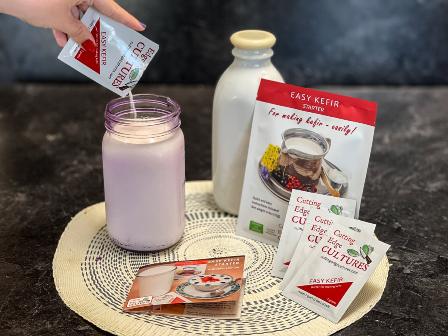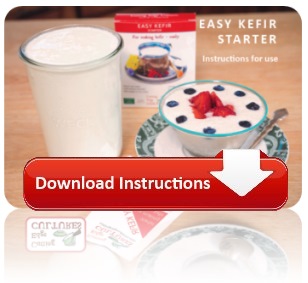Product Overview
Ingredients: Active bacteria strains (L. lactis, L. cremoris, L. diacetylactis, L. acidophilus, Saccharomyces cerevisiae, Kluyveromyces lactis), kefir grains, maltodextrin.
Contains live strains. Gluten-free. Non-GMO.
Packaged in a facility that also handles products that may contain wheat, soy, eggs, milk, and fish.
Cultures at room temperature!
Kefir is a cultured drink, traditionally made by adding kefir “grains” to various types of milk. We went a step further and freeze-dried the kefir grains into a powder to make our EASY KEFIR starter.
It’s fun and very easy to make! Kefir is a fantastic source of many nutrients, supplying you with calcium, magnesium, vitamins K and B and billions of friendly microbes that help your microbiome thrive and flourish.*
Kefir is even more potent than yogurt, with its numerous beneficial strains of organisms. Over a period of 24 hours or so, the microorganisms in Easy Kefir multiply and ferment the natural sugars in the milk, turning it into kefir.
Kefir has been credited with helping to boost the immune system, and is often consumed in order to help replenish the body with good bacteria after antibiotic use*.
Simple to make: add one packet to a quart of your choice of dairy milk. Let it culture for 18-24 hours at room temperature, and you have a delicious pourable drink. Hippocrates stated that "all diseases begin in the gut." Kefir is the perfect remedy to bring the gut back into balance*.
*These statements have not been evaluated by the FDA. This product is not intended to diagnose, treat, cure or prevent any disease.
And there's a bonus, too! Once you've made a batch of kefir using our Easy Kefir starter, you can use some of it to culture your next batch. This is called 'reculturing' and can be repeated at least 7 times!
This product is formulated to ship without refrigeration. Refrigerate or freeze it on receipt until you're ready to use it
Instructions
Makes: 1 quart kefir
Preparation time: 2 minutes preps, 16-24 hours culturing
You'll need:
- 1 packet of Easy Kefir starter culture
- 4 cups (1 quart) dairy milk. Most milks bought at the fridge section in the grocery store are acceptable, including whole milk, fat-reduced, non-fat, A2, pasteurized, and homogenized. Avoid ultra-pasteurized. Avoid raw milk. Goat milk will yield a thin result. (If using cream or Half & Half: In a quart jar, whisk 2 cups + starter + 1 tbsp. of Prebio Plus. Add 2 more cups and mix with a spoon. Secure the lid. Proceed to instruction #3 below)
- Quart jar with lid
Steps:
- Pour four cups of milk into a quart-sized jar. The milk doesn’t need to be warm, it can be cold from the fridge.
- Sprinkle the entire contents of one Easy Kefir starter packet into the jar and mix well with a spoon. Secure the lid.
- Let the mixture ferment at room temperature (ideally around 72° - 75° F) for 18 to 24 hours. If the temperature is below 72° let it ferment a little longer. You will know your kefir is ready when the milk has thickened and has a distinctive, sour fragrance. Final consistency is akin to a pourable yogurt.
- Place in the refrigerator. Even in the refrigerator the fermentation process will continue, but the chill will slow it down.
Reculturing your kefir
Kefir made with a powdered starter culture can often be recultured several times. These subsequent fermentations can increase the nutrients in your kefir, and make it even tastier!
The exact number of successive 'reculturings' will depend on the freshness of your kefir. We recommend reculturing within 7 days. Longer periods between batches will decrease the likelihood that the new batch will culture successfully.
To reculture:
1. Pour 3 ¾ cups milk into your quart-sized glass jar.
2. Add ¼ cup kefir from the previous batch and stir gently.
3. Cover with a lid and place on counter for 16 -24 hours, or until thick and tart.
4. Place in your refrigerator when ready.
** Looking for non-dairy versions? Please see our partner Cultured Food Life's dairy-free recipes **
FAQs
- What's the difference between kefir grains and the Easy Kefir starter culture? Our Easy Kefir starter culture is a powder made from freeze-dried kefir grains. It contains all the strains and yeasts present in dairy kefir grains, and conveys all the benefits of kefir grains, without the actual grains. Our Easy Kefir starter does not create grains at any stage during fermentation, nor after it. Once you've made a batch of kefir using our Easy Kefir starter, you can use some of it to culture your next batch. This is called 'reculturing' and can be repeated several times over.
- Will I need to look after grains if I use the Easy Kefir starter culture? No. See "What's the difference between kefir grains and the Easy Kefir starter culture?"
- Can I make a new batch from a previously-made batch, without grains? Absolutely! Once you've made a batch of kefir using our Easy Kefir starter, you can use some of it to culture your next batch. This is called 'reculturing' and can be repeated several times over.
- At what temperature is kefir fermented? At room temperature. Ideally, around 72°F to 75°F. Just place the jar on your kitchen counter. Optional: If your kitchen is too cold, place your jar in a warm "water bath" (a container filled with warm water, (not hot)). You will need to change the water once it has cooled, and you'll probably need to repeat this several times. You could also wrap your jar with a towel, blanket, sweater, or coat on all sides, including the top and bottom, and place it in an insulated coolbox (or similar method). You could also try using an appliance that will help keep the kefir gently warm during fermentation. Avoid overheating. Most yogurt makers will be too hot. See also "Is the fermentation affected by temperature?"
- Which appliance do I need for kefir fermentation? None. You just need a glass jar with a fitting lid. Optional: If your kitchen is too cold, place your jar in a warm "water bath" (a container filled with warm water, (not hot)). You will need to change the water once it has cooled, and you'll probably need to repeat this several times. You could also wrap your jar with a towel, blanket, sweater, or coat on all sides, including the top and bottom, and place it in an insulated coolbox (or similar method). You could also try using an appliance that will help keep the kefir gently warm during fermentation. Avoid overheating. Most yogurt makers will be too hot.
- Do I need to pre-heat the milk? No, no need. You can use cold milk from the fridge.
- Can I use raw milk? No. It contains competing bacteria. If you wish to use it, you will need to pasteurize it first.
- Can I use goat milk? Yes, but the result will be thin.
- How does the fat content of the milk affect the kefir? There's a direct correlation between the fat content of the milk that you use, and the creaminess of the resulting kefir. Whole milk with a higher fat content will result in a rich, creamy kefir, while skim milk will produce a much thinner texture.
- Why is there maltodextrin in the Easy Kefir starter culture? Every starter culture requires a 'carrier' for functionality and performance. The maltodextrin adds bulk to the powder (which would otherwise be too tiny to manipulate) and provides energy for the fermentation to proceed. It is needed as food for the fermenting bacteria, and will be consumed by them during fermentation. Once fermentation is complete, hardly any trace of maltodextrin is left. Subsequent batches, where the existing kefir is used as a starter, will have no maltodextrin in them at all. The maltodextrin in our Easy Kefir starter is non-GMO. Each sachet of starter contains only 1 gram of maltodextrin which will be diluted in 1 quart of milk during fermentation. The ratio of dilution is 1/1000 which is minuscule to begin with.
- Why is the starter shipped without ice? See "I live in a hot place. Is the starter still active after being shipped unrefrigerated in hot weather?"
- Do you ship to Hawaii / Alaska / Puerto Rico? Yes. Shipping fees to Hawaii, Alaska, and Puerto Rico are the same as to any address within the contiguous USA. We use ambient shipping (non-refrigerated and without ice). Our starters are designed to remain active for several weeks in transit in hot weather, without refrigeration or ice. The formula and the packaging provide excellent protection for the live strains. See "I live in a hot place. Is the starter still active after being shipped unrefrigerated in hot weather?"
- I live in a hot place. Is the starter still active if it's shipped unrefrigerated in hot weather? Yes. Our starters are not affected by heat in unrefrigerated transit. They are designed to remain active for several weeks in hot weather, including heatwaves, without refrigeration or ice. The formula and packaging provide excellent protection for the live strains. They are freeze-dried and not heat-sensitive in the sealed packet. We have thoroughly tested this. For this reason, we use ambient shipping, which is significantly less costly for the customer. We keep the starters in a cold warehouse until orders are shipped, and when your order is shipped we send you a tracking number so that you can see when it is due to arrive. Once received, the starter should be refrigerated or frozen for the longterm, and you can use it as normal. It's normal for the first batch to come out 'weaker'. The bacteria take a cycle or two to fully kick into gear. This has nothing to do with the unrefrigerated shipping. See "How do I know my kefir is properly fermented?" and "I forgot to refrigerate the starter. Is it still active?"
- I forgot to refrigerate the starter. Is it still active? This depends on how long the starter has been left at ambient temperature and if the Best By date is still valid. The starter is designed to remain active for several weeks (and depending on ambient temperatures, even longer) at room/warm temperatures (usually for transit purposes). The formula and the packaging provide excellent protection for the live strains. If the delay is much longer and the temperatures are very high, the viability may be affected. That said, reduction in viability is a slow process that does not happen immediately, even past Best By date. You could try compensating for the possible decrease in viability by increasing the ratio of starter to dairy (for example, by using 2-3 sachets to make one quart, leaving the rest of the ingredients unchanged), and by fermenting for a little longer if needed, to let the bacteria catch up by proliferation over time. See instructions. Also see "How do I know my kefir is properly fermented?". There's no harm in consuming inactive bacteria; this is equivalent to consuming no bacteria at all. If all goes well, you could later use some of your ready batch to make future larger batches. Remember to keep the starter refrigerated (or frozen) until you're ready to use it. See also "I live in a hot place. Is the starter still active after being shipped unrefrigerated in hot weather?"
- Is the starter gluten-free/soy-free/dairy-free/lactose-free/vegan? Although the Easy Kefir starter culture ingredients contain no actual gluten and no soy, the starter is packaged in a shared facility that also handles products that may contain wheat, soy, eggs, milk, and fish. The grains themselves were originally developed on milk. There may be a trace of dairy in the product. Easy Kefir starter is primarily designed to ferment dairy.
- Is the starter certified Kosher? No. Our starters are not certified Kosher.
- Can I make non-dairy kefir with the Easy Kefir starter culture? The Easy Kefir starter culture is primarily designed for dairy milk fermentation. For dairy-free versions, please see our partner Cultured Food Life's dairy-free recipes.
- Where should I store the Easy Kefir starter culture? In the refrigerator or in the freezer.
- Is the fermentation affected by temperature? Yes. Ideal temperature for kefir fermentation is 72°F to 75°F. Overall, fermentation is faster in warm weather and slower in cold weather. If the room temperature is below 72°F let the kefir ferment a little longer than the recommended 18h-24h, if needed. You can open the jar and check. See "How do I know my kefir is properly fermented?". During summertime, if the weather is really hot, check your kefir after 12 hours. Optional: If your kitchen is too cold, place your jar in a warm "water bath" (a container filled with warm water, (not hot)). You will need to change the water once it has cooled, and you'll probably need to repeat this several times. You could also wrap your jar with a towel, blanket, sweater, or coat on all sides, including the top and bottom, and place it in an insulated coolbox (or similar method). You could also try using an appliance that will help keep the kefir gently warm during fermentation. Avoid overheating. Most yogurt makers will be too hot.
- How long will the resulting kefir keep in the fridge? It wil keep for several weeks. Flavor and texture may change over time. See also "How should I store the kefir while I'm away?"
- Can I freeze the kefir? Yes, freezing does not kill the bacteria. You can make ice cream with it but expect the texture to be grainier/thinner. Please note, however, that we haven't tested batches recultured from a previously-frozen batch. If you plan on consuming/reculturing the kefir within several weeks, you don't need to freeze it. Keep it refrigerated. Flavor and texture may change over time.
- How should I store the kefir while I'm away? If you plan on consuming/reculturing the kefir within several weeks, keep it in the fridge. Flavor and texture may change over time. Viability will eventually reduce too, but if your absence does not exceed several weeks, your ferment should kick back into gear once fresh milk is introduced. When you get back, check if it's still good, and reculture a small quantity (1 liter/1 quart). You may need to extend culturing time to let the bacteria catch up by proliferation. It may take a few cycles to return to full vigor. If the new batch turns out fine, keep using it. If not, discard, and use a new starter from a sachet to start over. Please note that although freezing does not kill the bacteria, we haven't tested batches recultured from previously-frozen batches.
- Can I use metal utensils and lids to handle ferments? Overall yes, because the metal used in utensils and food-grade lids is most probably acid-resistant, and the utensil is not going to touch the ferment for that long. Metal lids can be used provided that they are acid-resistant and do not directly touch the fermented product for an extended period of time. Opt for the type of lids with a waxy interior, used for pickles, for example. If that interior is corroded though, better not use them. Also: the jar should not be full all the way to the top, to avoid direct contact between the ferment and the lid. There's no problem using stainless steel in the preparation stage, before fermenting.
- Can I use a blender? Better not. Blending could be too forceful for the live microorganisms and may result in the shearing of many of them, in which case you will get fewer live bacteria. Whisking, on the other hand, is fine. If you make a smoothie, we recommend stirring the kefir into the smoothie after the rest of the ingredients have been blended, or keeping the blending to a minimum and using the lowest speed possible.
- Why has my kefir separated into liquids and solids? Separation into curds (solids) and whey (liquids) is fairly common, and is the result of over-fermentation. Either the kefir has been fermenting for too long, or the ambient temperature was too warm, or too much starter has been used per the quantity of milk. Separation is even more common in subsequent batches (when a previously-made kefir is used to start a new batch), as the kefir tends to get stronger with each batch. If it smells good and tastes good (a tangy-yeasty, pleasantly-sour flavor and aroma), you can still use it. Some people like to mix the curds back into the whey; others drink the whey, and eat the curds as soft cheese.
- How do I know my kefir is properly fermented? For obvious reasons, it's hard for us to assess your kefir from afar, but overall, what you're looking for in your kefir is:
- Flavor: nicely tart, mildly yeasty, slightly fizzy/zesty, and may have a hint of some yeasty sweetish-ness (assuming you used plain dairy, not a sweetened one. This natural sweetness is from the lactose in the milk). First batch tends to be fairly mild. It will get stronger in subsequent batches. It might take several batches to kick into full gear. It shouldn't taste off/unpleasantly pungent. It's very normal for a homemade kefir that is made from a starter culture to taste quite different than a store-bought one.
- Smell: some faint sour-dairy aroma, or none. It shouldn't smell spoiled.
- Consistency: different levels of pourability, depending on the dairy used. Kefir is fairly pourable overall, but not like water. More like thin yogurt. May granulate somewhat or separate into solids and liquid (curds and whey) due to the relatively long fermentation. Both curds and whey should be pleasant to consume.
- How many times can I reculture? For as long as your batch comes out pleasantly tart and lightly fizzy, and thickens to the consistency of thin yogurt. See "How do I know my kefir is properly fermented?"
- I've been reculturing many times. How will I know it's time to start over and use a starter from a sachet? When your batch is too sour, or doesn't thicken as before, it's time to start over. See also "How do I know my kefir is properly fermented?" and "How many times can I reculture?"
- Is kefir boozy? Kefir contains natural yeasts. When these yeasts ferment, they naturally produce a faint trace of alcohol that is too minute to have any significance but can still imbue the flavor with some light zest.
- What are the starter's caloric/nutrition facts? These are printed on the back of the pouch. But overall, our starters contain such minuscule quantities of powder, that they are too tiny to have any impact on the final result's caloric values. Our starters come in sachets of 1g - 3g of powder (depending on the starter), most of which, apart from the live strains, is either a carrier fiber containing no caloric value, or a trace of a natural sugar containing only a negligible value. When these teensy quantities of 1g - 3g are added to a quart of dairy, the starter's original caloric values, if ever there were any, become entirely diluted in the overall mass, and are practically non-detectable. The final result's nutritional values of calories/fats/carbs etc., come directly from the dairy that the starter was added to, not from the starter itself. For example, if you use Half & Half, it will add more fat to your final result than skim milk.


















